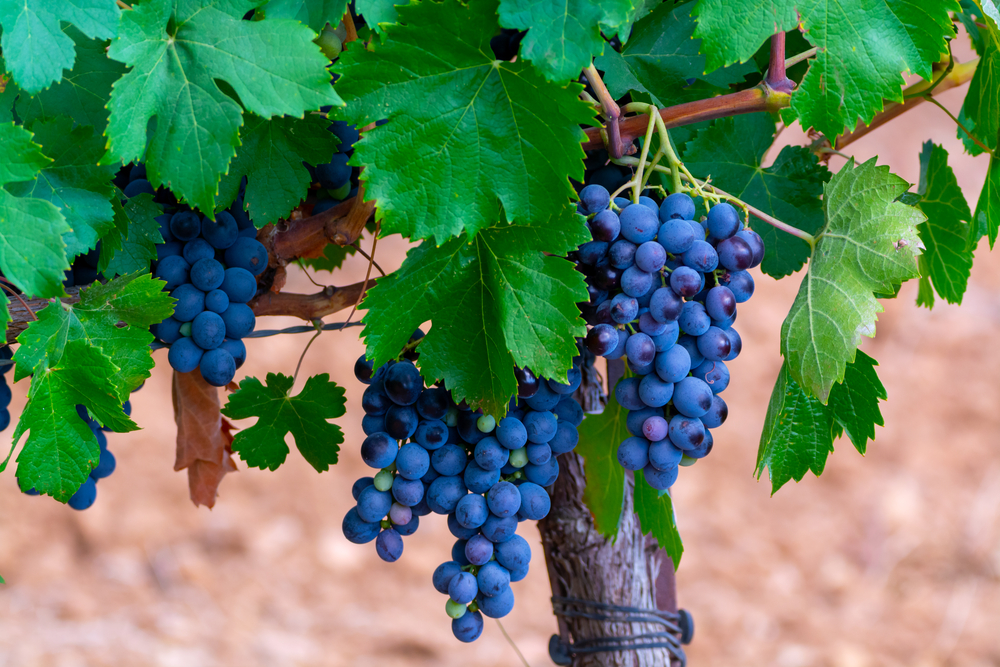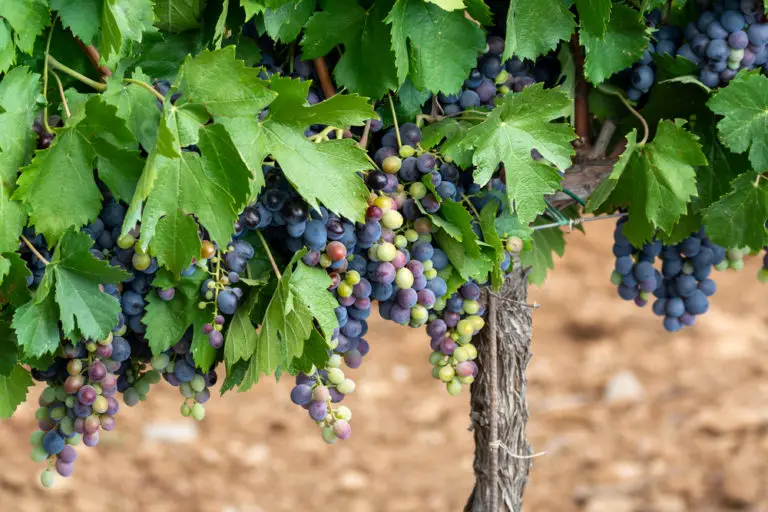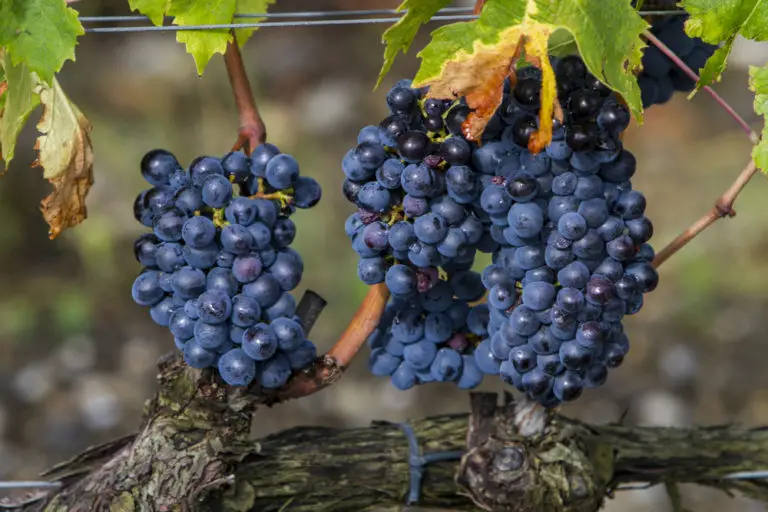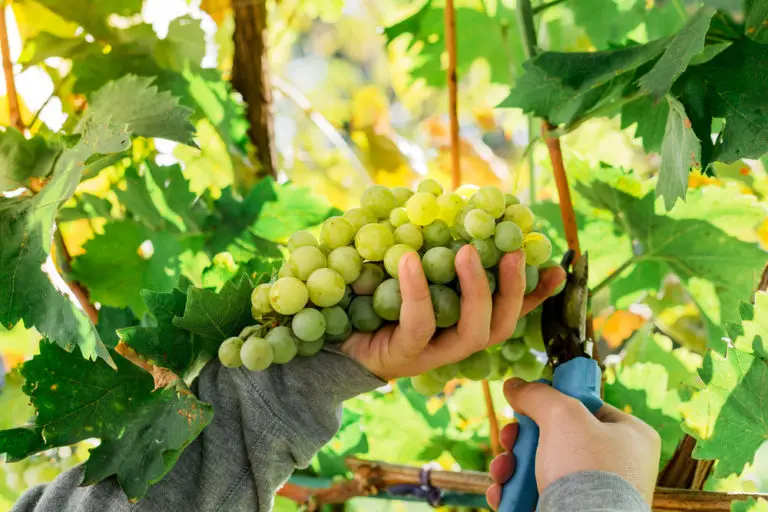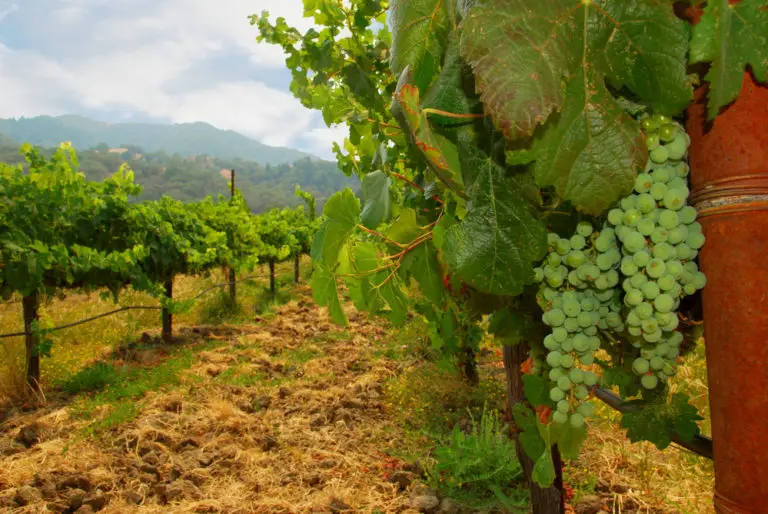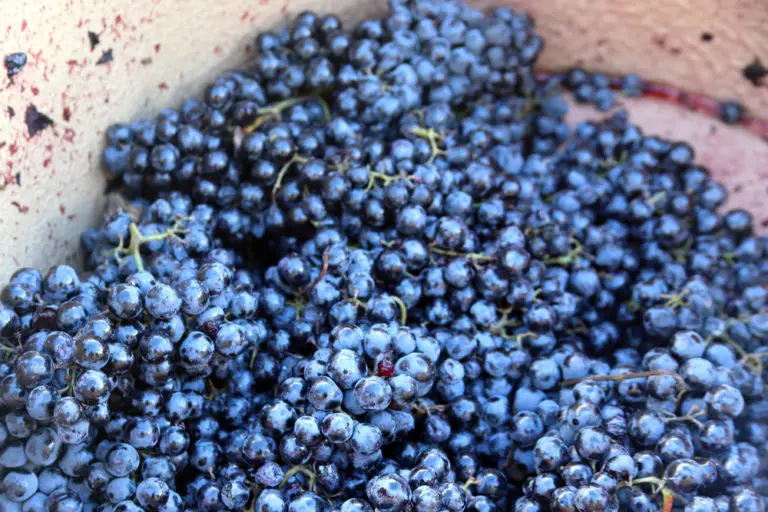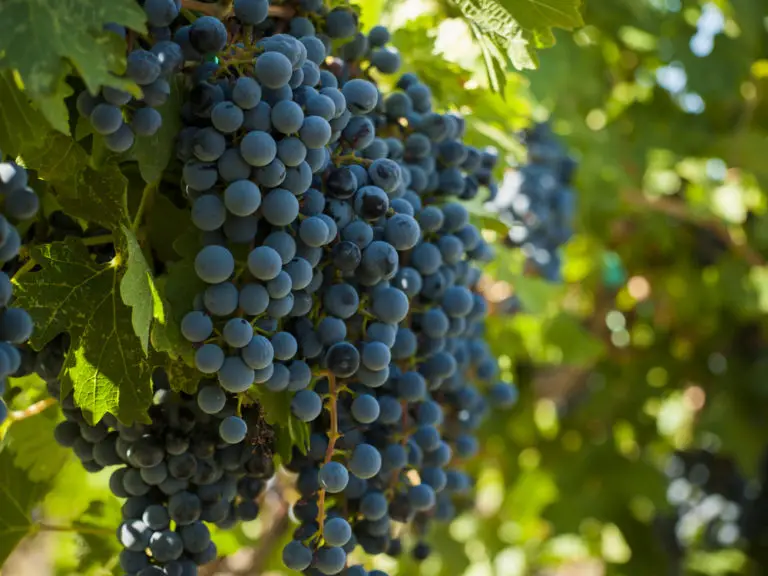Grenache: The Beginners Guide (2024)
The grape Grenache Garnacha originally comes from Spain and is very popular because it produces fruity wines. It also gives a lot of pleasure to “occasional connoisseurs”. Although these are alcohol-intensive, the skins contain few tannins. These wines are low in acid and taste very fruity and full-bodied on the palate.
Wine Color: Red garnet color
Characteristics: Medium-full body, medium tannin, and acidity
Color of berry skin: Noir
Flavor: Dry
ABV: Over 15%
Origin: Aragon region of Northern Spain
Notable Regions: France, Spain, Australia, and the United States
Most Expensive Bottle: Chateau Rayas Chateauneuf-du-Pape Reserve, Rhone, France
Common synonyms: Grenache Noir, Garnacha Tinta, Garnatxa, Lladoner, Tinto Aragones, Cannonau, Granaccia, Tocai Rosso
- What is Grenache?
- Known Regions for Grenache
- Popular Blends of Grenache
- How to Enjoy Grenache?
- How is Grenache Made?
- History of Grenache
- Alternatives for Grenache
What is Grenache?
Grenache is a very old, widespread grape variety. It has many different names depending on the growing region, and yet, it is always the same, unmistakable variety everywhere- whether in Spain, Italy, France, or Sardinia, where it is known as Cannoau.
The vines are very resilient to drought, which is why they are so popular in hot areas.
They are not only available in red Grenache wine color (Grenache Noir) but also gray and light versions, light to dark red wines, and rose and white wines are made from the grapes.
Wines that impress the palate with their soft fruitiness are rather low in tannins and therefore high in alcohol and have characteristic aromas of cherries, blackberries, blueberries, or pomegranates.
However, some winemakers grow pure Grenaches with low yields, which are usually known as Grenaches Noir. It brings them to full maturity to obtain highly concentrated, full-bodied, spicy dark-colored wines that can be stored for a long time. Grenache pronunciation is gruh·naash.
Grenache vs. Pinot Noir vs. Syrah
The Grenache grape has a lot in common with the great grape variety from Burgundy, Pinot noir. First, both grape varieties come in three colors.
Because, in addition to the red or “black” (“noir”) variant of the grape variety, the Grenache blanc (“white”) is also widespread in the Mediterranean region, and also, albeit less, the Grenache Gris (“grey”).
Secondly, both grape varieties are very delicate and only the most skillful hands succeed in getting the full taste and aroma potential out of the pulp and skin and combining them in a harmonious wine.
Grenache and Syrah, on the other hand, are equally popular varieties. The grape variety Grenache is the fourth most common grape in the world, and Syrah the sixth most common. Both come as first-class varietal red wine, cuvées and can always emphasize their strengths.
Grenache grapes are mainly found along the Mediterranean coast from the southern Rhône to the Priorat, where it produces fine to very fine wines on poor soil. While Grenache has few tannins and is therefore soft and fruity.
Grenache Characteristics
The list of the most famous Grenache wine regions has already indicated it. The Grenache varietal copes well with dry, warm climate conditions, and the vine survives longer periods of heat without major damage.
In addition, Grenache can be assigned to the late-ripening grape varieties, the grapes even need long summers to exploit their full potential.
Grenache Noir develops intensive fruit aromas, but with its high sugar content, it also stands for wines with a lot of alcohol. In contrast, the tannins of the grape variety are rather moderate. The color of a Grenache profile is much lighter than expected for this full-bodied wine.
But the berries only have thin skin, so less coloring is released. Especially the light color and the wonderful fruit aroma recommend Grenache characteristics for the production of rosé wines.
Grenache Taste Profile
The Grenache variety produces wines that are poor in tannins and color but full of fruit and body. In California, they are also used for rosé or white wines. Because of the low tannins, they get a rather pale coloring, which they make up for with their rich aromas.
Grenache tasting notes leave behind cherries, blackberries, currants, wild berries, plums, dark chocolate, tobacco, spices, Mediterranean herbs, and cocoa with spiciness and refreshing minerality in the mouth.
Very often, the vine ends up in the blend, or noble cuvée with varieties that contain a lot of tannins, such as Tempranillo, Mourvedre, or Syrah since it is a vine rich in alcohol but is still soft.
Aromas of strawberries and raspberries, combined with leather, Note pepper, and coffee or mocha. Wines from the French grenache vine attract attention with their warm character and are seductively flattering on the palate.
Grenache Ageability
It is assumed that only the best and most expensive wines can age, but all the well-made wines can develop well. Modern wines from fine wines can age for four to five years unless they are made for aromatic flavors. Wines with a real taste concentration, with a good balance between texture, acidity, and alcohol, can age well.
But some wines are specially made for extended aging, such as highly extracted red wine having bold tannins that take time to soften. It is reflected in the fine wines of classic New World and European regions.
Well-made red wines age fantastically, even for only four to five years. It is often surprising how well they can retain their freshness. Some countries have legally defined terms for wines that have been aged before the sale. These wines already have a certain bottle age, but they can be stored even further.
Notable Regions for Grenache
Grenache is believed to have originated in Spain, though today the grape is cultivated all over the world, notably in Australia, Croatia, France (Southern Rhône), Sardinia (where the grape is called cannonau), and Spain.
It needs a long growing season to achieve full ripeness, at which point it has high alcohol potential and significant fruit sweetness.
France
The French Grenache wine variety occupies around 97,000 hectares. The focus of cultivation is in the Rhone Valley in the departments of Vaucluse and Drome, where the wines Costières de Nîmes and Château-du-Pape are obtained from pure Grenache. Vin doux Naturel, fortified sweet wine, has Grenache vines in its components, and the Syrah grape variety is very often used as a blending partner.
Italy
In Italy, the Grenache alcohol content is found under the name Alicante. But it is also cultivated in Sicily and Calabria. In Ischia, this vine is called Guarnaccia, and in Sardinia, where it is the most important red variety. The poor soil and dry heat are perfect for this grape variety and represent ideal climatic conditions.
Australia
In Australia, Grenache is typically used as a component of the GSM blend or goes into making sweet fortified wines. The Barossa Valley and McLaren Vale contain some very old Grenache vines from the late 19th century. These wineries are known for richly structured Grenache-based wines.
Croatia
In the northern part of this wine-growing region of Croatia, conditions are very similar to Rhone in France. It is, therefore, not surprising that mainly the typical Rhone varieties are grown in this part of Northern Dalmatia. This Grenache region offers remarkable quality and plays a vital role in the international wine market.
Sardinia
Another place where Grenache Noir thrives as a monocépage is in Sardinia, where it goes by the name Cannonau. You often see this Grenache name pontifically on the label because the Sardinians are very proud of their Cannonau di Sardegna. It brings us to the origin of this blue grape because both the Sardinians and the Spaniards claim that Grenache is their grape originally.
Popular Blends of Grenache
Grenache is widely used in making blends. It is mostly blended with some popular varieties like Syrah, Carignan, Cinsault, and Cabernet Sauvignon. Even when it is not the dominant variety in a blend, its garrigue-like herbal and cherries notes tend to add wonderful fruit and spice to each sip. Here are some popular Grenache blends:
Les Granes d’Grenachieres 2017 Demeter-Wein
The Chateauneuf du Pape “Les Granes d’Grenachieres” is the absolute top red wine from Simian. It has a deep violet Grenache color, having aromas of blackberry jam, cherry mixed with paprika, curry, and saffron. An Intense attack, immediate explosion, velvety and fleshy roundness, silky tannins of remarkable intensity are present in a very nice balance of fullness, length, and freshness.
Dardell Negre Seleccion, 2018, DO Terra Alta
This wine is an elegant, fruity-soft red wine. It has cherry and violet tones typical of its youth with a nose that reveals the aromas of ripe fruit (blackberry), chocolate, and finely spicy notes of Syrah. The fine, fresh acidity in the mouth brings the sensations of ripe fruit more present before giving way to a pleasant and fine tannin. It has 80% Garnacha Tinto and 20% Syrah & Cabernet Sauvignon.
Domaine du Joncier, Lirac ici 2017, France
It is a fine, spicy-mineral red wine characterized by Grenache taste. This Fruity and fresh wine has hints of red fruits and some cherries. It has a balanced tannin structure, and nice concentration with a smooth, soft structure on the palate with a long aftertaste. It has Grenache alcohol 65%, Syrah 20%, Carignan+Cinsault 15%.
Sablet Cotes du Rhone Village Rouge AOC 2019, France
This dark red wine is a blend of Grenache abv, Syrah, and Mourvedre. It has a delicious bouquet of blackberries, notes of undergrowth, and thyme. The fruits explode in the mouth, then sweet spices and some licorice are added. It is open-hearted, having round tannins. A top-class red wine from the southern Rhone.
Domaine du Joncier, Cotes du Rhone I´O 2018, France
This 70% Grenache alcohol percentage and 30% Syrah is a very balanced fruity red wine. It has Delicious, light spice, and good freshness in the aftertaste. The Silky soft tannins and aromas of fresh red fruits are best served slightly chilled. It is best served with light cuisine like Hearty seasoned vegetable platters and terrines.
How to Enjoy Grenache?
Grenache is one of the more versatile pairing wines out there. As a standalone wine or blended with other varieties, Grenache’s full-bodied qualities make it great. Like any other wine, it comes with recommendations to bring the best Grenache flavor profile and aroma based on the types of Grenache. Let us take a look at Grenache wine pairing:
Food Pairings
Grenache can be a real addition to many dishes due to the light base of fruit and tannins and the lack of much spiciness of new oak. It also copes well with spicy foods without overpowering them. Some dishes to try with your Grenache wines include:
With this Spanish Grenache, you can go in many directions. The wine is concentrated but also accessible. It is the wine for a summer BBQ because it tastes perfect with all types of grilled meat (lamb, burgers, sausages, chicken, and steak). But also delicious with Italian osso buco, Moroccan tagine, or Asian dishes.
You can also go with a milder taste, for example, vegetarian dishes with mushrooms or eggplant and tomato, pasta bolognese, or a hamburger from the BBQ. Some more options can be beef, tomato-based soups, stews, lobster Thermidor, cioppino or bouillabaisse, mushroom dishes, cassoulet, chili con carne, roasted vegetables, pasta with red sauce, and jambalaya.
Temperature
It is no secret that white wine is kept in the fridge, and red wine is kept outside the refrigerator. But, is it not recommended to keep red wine refrigerated? In general, red wine is kept at room temperature usually between 18 and 21 degrees.
Still, most red wines thrive at a lower temperature, preferably between 16 and 18 degrees. Red wine should not be exposed to too much light and heat, like the aroma and taste, which can be lost in this way.
In addition, it differs per red wine how it can best be stored. In general, a temperature between 16 and 18 degrees applies to most red wines. A fruity and fresh red wine prefers a temperature between 14 and 16 degrees.
A true wine lover can purchase a wine cabinet, otherwise, you can temporarily store the wine in a dark place, for example, in the cellar or elsewhere in the house.
The optimal temperature for drinking Grenache wines is between 15 and 18°C.
Stemware
There are many types and sizes of wine glasses, but which wine glass do you use for which wine? You may think it does not matter which wine glass you use, but it does not. A wine glass is specially designed to be used with a certain type of wine.
The shape of a wine glass and the clarity of the glass are essential to allow the senses to do their work as optimally as possible. When a wine is poured into the wrong glass, the character of a wine cannot develop properly.
Bordeaux Wine Glasses
Wines from the Bordeaux wine region can be recognized by the fact that they are powerful and fruity. These wines, therefore, require a voluminous, longer, and slightly tapered chalice. The aromas thus travel a long way upwards and develop optimally before they reach the mouth.
White Wine Glasses
White wine glasses are usually smaller and less bulky than red wine glasses. The opening of the glass is narrow and tapered. As a result, the aromas do not dissipate so quickly, and the balance between the sweetness and the acids remains in balance. The aromas come into their own better in a smaller chalice.
How is Grenache Made?
Depending on the winemaker, Grenache is produced in a variety of styles from dry wine to sweet wine. It has quite large berries with relatively thin skins, and given the warm areas it is grown in, it often reaches ripeness quite readily, meaning the wines can be pale in color, with high alcohol and lowish tannin. Here is the process of Grenache wine making:
1. Harvest
The winemaking process begins with the harvesting of the grapes. Harvesting is done mechanically or by hand. Flat Grenache vineyard can be harvested by machine, steep, and difficult vineyards are always harvested by hand. Harvesting manually has two advantages. Unripe, and bad bunches are not picked and the grapes are hardly damaged by manual picking.
2. Pressing
After picking, the grapes are crushed (pressed) and usually completely stripped of the stems. The stems contain a lot of tannins, which makes the wine tart. Bruising releases the Grenache flavor that is in the skin of the grape. The grape juice produced by crushing is called must. By soaking stems, seeds, and skins in the juice for a while, more acids and tannins end up in the juice.
3. Fermentation
After pressing, the must begins to ferment slowly. During this alcoholic fermentation, the sugars in the must are converted into alcohol. After fermentation, the must is turned into so-called young wine. This young wine contains a lot of malic acids and is therefore quite hard and sour. If the wine is left for longer, it will start to ferment again after a few months.
4. Aging
After fermentation, the wines are stored in barrels. Some wines mature in oak barrels, but not all wines are suitable for this. It is mainly the powerful, characterful red wines that can mature in wood. Such wines are stored for several weeks to even 24 months. Most whites and light reds are stored in stainless steel vats for several months.
5. Transfer and Filter
The yeasts and other components settle to the bottom and are removed. You can add sulfur to protect the wine from oxygen. In some regions, wines from different grapes or plots are brought together and mixed, this is called assembling. To remove the suspended particles in the Grenache wine ingredients, a fining agent is often used, and the wine is filtered to make it even clearer.
History of Grenache
Garnacha wine knows that success grows with secrets. The origin of the red vine has been a much-discussed topic for centuries without a clear result. Both Sardinia and the Spanish region of Aragón see themselves as the home of the grape variety and have their own stories. No wonder, because every country would like to win over such an important grape variety.
In Italy, wine lovers assume that the Aragonese traveled to Sardinia in the 14th century and encountered the Garnacha grape there. The character of the grape variety convinced the early discoverers so much that they took it to Spain without further ado and cultivated it there.
However, the theory of the Spaniards states that the Garnacha was already at home in the Aragon region in the 12th century and only spread from there. However, it should be clear that France is not the origin of the vine because the language of the first stocks was only here in the 17th and 18th centuries.
Alternatives for Grenache
You can find great value and high quality in other popular wine varieties which taste very similar to the wine you already love. Similarly, you can try drinking Pinot Noir, Syrah, and Merlot if you love to drink Grenache. Here are some alternatives from Grenache that you must try.
Pinot Noir
Pinot noir, the mother grape of the Pinot family, is known worldwide for its red Burgundy wines. It is a popular grape variety among wine enthusiasts and winemakers, and for good reason. Wine lovers love this grape for its smooth taste and versatility. Wines from the pinot noir grape give elegant, smooth, and fruity wines.
Syrah
Syrah (or shiraz) is one of the most famous grape varieties in the world. It is one of the most widely planted grape varieties worldwide. The wine from the Shiraz grape is known for its dark purple color. Syrah wine has a lot of body, medium acidity, and medium tannin content.
Merlot
A glass of Merlot wine is soft, creamy, and full of fruit. It has an intense, fragrant taste with fruity aromas of berries, cherries, and plums. You can also encounter the taste of chocolate in a merlot wine. The Merlot is a fairly large grape with thin skin that contains less coloring matter and fewer tannins.
FAQ
What is Grenache wine?
Grenache is the second most widely planted grape in Spain. The taste of the wine is often very strong and on the sweet fruity side.
What does Grenache mean?
Grenache meaning is a red grape variety that relishes heat and can relatively easily produce ripe, full styles of wine. It is generally berry-flavored and soft on the palate.
What type of wine is Grenache?
Grenache is a wine that has little tannin and has low acidity. The wines also contain many spicy aromas, such as fennel, pepper, ginger, cinnamon, and bay leaf).
Is Grenache dry or sweet wine?
Grenache is a medium-dry wine that matures late in the season, which gives the wine a high alcohol percentage. The grape does well in a dry and hot climate.
Is Grenache red or white wine?
Grenache is a dark-skinned red wine grape. It has a typical smell of freshly ground white pepper. In an older Grenache, the spicy notes of tobacco occur.
Is Grenache a good drinking wine?
Garnacha is a versatile grape that has been a silent partner for many other more celebrated varieties, it seems to be finally getting its moment in the spotlight.
How to serve Grenache?
The ideal temperature to serve Garnacha is about 60-65 degrees Fahrenheit. You can enjoy it with slow-cooked meats such as pork, lamb, beef, and even chicken.
How many carbs are in a glass of Grenache?
A glass of Grenache contains 4 grams of carbs (per 5 ounces serving). We recommend you check the label of the wine before consumption.
How many carbs are in a bottle of Grenache?
A 750 ml bottle of Grenache contains 20 grams of carbs. This dark-skinned red wine often contains added sugar, so, unfortunately, they are not keto-approved.
How many calories are in a glass of Grenache?
There are 122 calories in a glass of Grenache. It is not ideal for weight loss. 122 calories are equal to 15 Tamari or Marcona Almonds.
How many calories are in a bottle of Grenache?
A 50 ml bottle of Grenache contains 630 calories. It is equivalent to eating a big bucket of movie popcorn or a quarter-pound burger with cheese.
Where is Grenache wine from?
Grenache origin from the Aragon region of Northern Spain, which is also considered the birthplace of Carignan. Some people believe that it originated in Italy.
What does Grenache taste like?
Grenache taste profile is influenced by flavors of white pepper, herbs, and fruit. The high sugar content is typical of this wine and also makes it sweet and firmer.
What does Grenache smell like?
This wine has powerful aromas of blackberries, pepper, cherries, berries, and a slightly spicy scent. In an older Grenache, the spicy notes of tobacco occur.
What does Grenache pair with?
This wine is perfect to combine with spicy dishes, beef, tomato-based soups, stews, vegetarian dishes with mushrooms or eggplant, and tomato, roasted meat, or tapas dishes.
How much does a bottle of Grenache cost?
An affordable Grenache can cost as low as $4, while the most expensive wine “Chateau Rayas Chateauneuf-du-Pape Reserve, Rhone, France” is available at $2,000.
How is Grenache wine made?
Depending on the winemaker, Grenache is produced in a variety of styles from dry wine to sweet wine. It can be of different colors based on the grape varieties.
What is Grenache wine similar to?
Grenache is a thin-skinned red wine. You can try Pinot Noir, Syrah, and Merlot if you love the taste and aromas of a Grenache wine.
What’s the difference between Grenache vs Garnacha?
Grenache and Garnacha are typically made from the same grape variety. If the wine is French, the grape is Grenache; if the wine is Spanish, it is Garnacha.
What’s the difference between Grenache vs Pinot noir?
Grenache is known to be “the next Pinot Noir.” It offers similar qualities like taste aromas, but it is more affordable than a Pinot Noir.
What’s the difference between Grenache vs Syrah?
Syrah has a darker palate, and the fruit flavors tend to the plum end of the spectrum. Grenache tends to be a bit more fruity and acidic.
What’s the difference between Grenache vs Cannonau?
Cannonau and Grenache are the same variety of grapes. Cannonau berries typically have thin skin, and they tend to ripen late in the season.
What’s the difference between Grenache vs Zinfandel?
Zinfandel is a sweeter wine as compared to Grenache. Grenache is a light, crisp wine, while Zinfandel is generally off-dry, rich, ripe cherry-picked, and slightly confected.
What’s the difference between Grenache vs Mourvedre?
Grenache– Mourvèdre wines are a staple of the southern French wine industry. The alcohol level of this wine is usually high contributing to a fuller body.

